Description 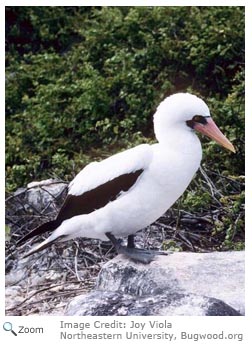 The masked booby is the largest member of the booby family. It is a little under three feet in length and has a wingspan of around five feet. The masked booby is the largest member of the booby family. It is a little under three feet in length and has a wingspan of around five feet.
It has a white body; brownish-black wings and tail; and a long, pointed orange-yellow bill. It has a black mask around its eyes and bill and large, gray webbed feet.
Range 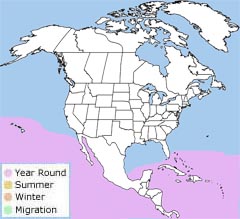 The masked booby breeds in the Caribbean and across the Pacific Ocean to Hawaii, Australia, and Indonesia. Occasionally, it is found in the Gulf states of Louisiana, Texas, and Florida. It winters in open ocean waters. The masked booby breeds in the Caribbean and across the Pacific Ocean to Hawaii, Australia, and Indonesia. Occasionally, it is found in the Gulf states of Louisiana, Texas, and Florida. It winters in open ocean waters.
Habitat
 The masked booby lives on the open ocean. It only comes on land to breed and raise its young. The masked booby lives on the open ocean. It only comes on land to breed and raise its young.
|
|
Diet
The masked booby plunges head first into the ocean to catch flying fish and squid.
Life Cycle
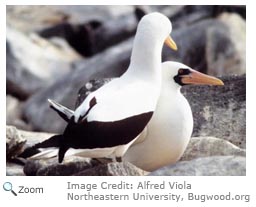 The masked booby makes its nest in a shallow depression on the ground. The female usually lays one to two eggs. Both parents incubate the eggs. They use their webbed feet to warm the eggs. The masked booby nests in large colonies. The masked booby makes its nest in a shallow depression on the ground. The female usually lays one to two eggs. Both parents incubate the eggs. They use their webbed feet to warm the eggs. The masked booby nests in large colonies.
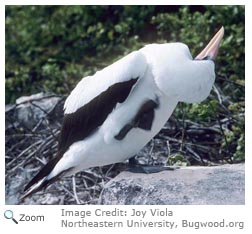 The eggs hatch in about 43 days. If there are two eggs, the first may hatch up to nine days before the second egg. The chicks fledge when they are a little over three months old. They continue to be cared for by their parents for another one or two months. Males mate with only one female. The eggs hatch in about 43 days. If there are two eggs, the first may hatch up to nine days before the second egg. The chicks fledge when they are a little over three months old. They continue to be cared for by their parents for another one or two months. Males mate with only one female.
Behavior
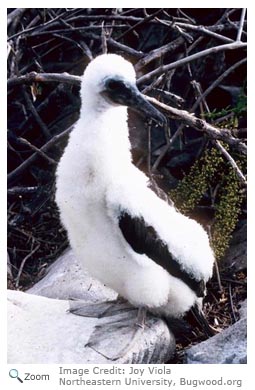 If masked boobies lay two eggs, usually only one hatches. In fact, masked booby eggs hatch only about 60 percent of the time. The second egg may be an "insurance egg" that raises the chances of at least one egg hatching. If the second egg hatches, the older chick often forces the younger chick out of the nest where it more than likely will die from heat or predators. The parents may even help the older chick by moving out of its way while it forces the younger chick out. While this may seem cruel, forcing the younger chick out increases the chances of survival for the older chick and in the long run the masked booby species because the parents are better able to care for one chick at a time. If masked boobies lay two eggs, usually only one hatches. In fact, masked booby eggs hatch only about 60 percent of the time. The second egg may be an "insurance egg" that raises the chances of at least one egg hatching. If the second egg hatches, the older chick often forces the younger chick out of the nest where it more than likely will die from heat or predators. The parents may even help the older chick by moving out of its way while it forces the younger chick out. While this may seem cruel, forcing the younger chick out increases the chances of survival for the older chick and in the long run the masked booby species because the parents are better able to care for one chick at a time.
|


 The masked booby breeds in the Caribbean and across the Pacific Ocean to Hawaii, Australia, and Indonesia. Occasionally, it is found in the Gulf states of Louisiana, Texas, and Florida. It winters in open ocean waters.
The masked booby breeds in the Caribbean and across the Pacific Ocean to Hawaii, Australia, and Indonesia. Occasionally, it is found in the Gulf states of Louisiana, Texas, and Florida. It winters in open ocean waters.



